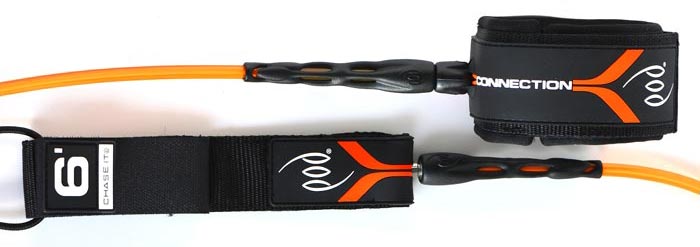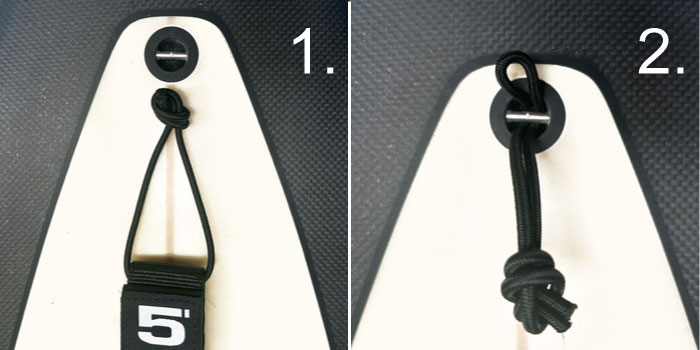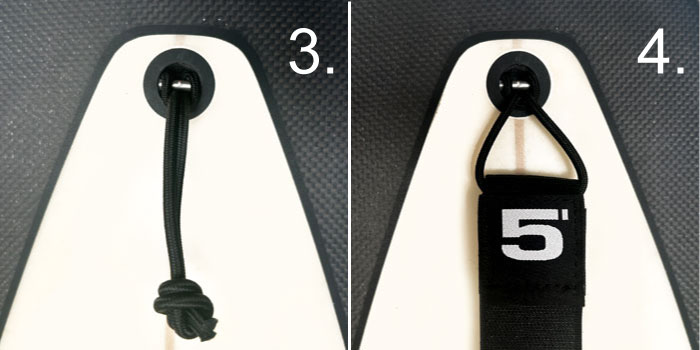Choosing the Right Size Surfboard Leash: Mistakes to Avoid
31st Aug 2024
Choosing the right surfboard leash is essential for any surfer, whether starting out or having years of experience. A good leg rope keeps your board within reach after falling off and ensures safety when paddling back to the wave break. But it's easy to make mistakes when picking a leash.
This Podware post will cover the mistakes to avoid when choosing a surfboard leash. Knowing these pitfalls will help you make smarter choices that keep you surfing.
Surfboard Leash History and Evolution
A surfboard leash is a necessary component for all surfers' convenience. But where did they come from? And how have they evolved over time? Let's take a dive into their history and development.
Early Beginnings
A leg rope was not always associated with a surfboard. When surfers fell off, they had to swim back to their boards, which was time-consuming until the leash was developed in the early 1970s.
The first surfboard leashes were quite basic. They were essentially pieces of surgical tubing or ropes attached to the board with suction cups. They were far from perfect; they often snapped or caused the board to bounce back dangerously towards the surfer.
1971 Innovation
using a urethane and invented the urethane leash known on surfboards today, a urethane cord that was strong and stretchy. This allowed surfers to stay connected to their boards without the risk of the leash breaking easily.
This innovation sparked much debate in the surf community. Some purists argued that using a leash was "cheating" and detracted from the skill of surfing. However, the convenience and safety provided by the leash soon won over most surfers.
Improvements Over Time
In the 1980s, Peter Clarke, the former owner of Full Bore, pioneered the first swivel connector by over-moulding it onto a urethane cord.
As years went by, surfboard leashes continued to improve. Manufacturers started experimenting with different materials and designs to enhance durability and comfort.
Our brand has taken a crucial surfboard leash surfing equipment and enhanced it with an advanced leash connection that prevents the swivel connector from over-spinning when stretched. The innovative advanced POD over-moulded unique connectors and unique design allow the 7mm cord to stretch up to six times its original length without twisting. Enjoy maximum strength, flexibility, and a safe, easy ride!
Here are some key improvements:
- Velcro Straps: Early leashes often had rudimentary attachments, but introducing Velcro straps and padded non-slip neoprene around the ankle made them much more secure and comfortable.
- Swivels: Adding swivels to either end of the leash reduces tangling; even a one-part swivel prevents the two parts from locking up, a common problem with early models. This allowed surfers more freedom and less hassle in the water.
- More substantial Materials and Components: Modern leashes are crafted from high-quality urethane and are known for their exceptional resistance to snapping. Using well-designed end connectors that stretch in unison with the urethane cord notably improves reliability. These advancements have notably increased the safety and dependability of surfing.
The Modern Leash
Today's surfboard leashes have improved through decades of innovative design tweaks. They are available in various lengths and thicknesses to suit different types of surfboards and wave conditions. Some even feature quick-release mechanisms for added safety, especially in big-wave scenarios.
Today, surfers have many options when choosing a leg rope that accommodates their needs. The once-debated equipment is now considered essential for surfing safety and enjoyment.
Leg rope history is a testament to how a simple idea can evolve into an indispensable surf accessory. It has saved countless surfers from potential harm and made this watersport more accessible for everyone.
Leading Role of a Leg Rope
Together, we will explore what a leg rope is and why it's crucial. It is one of the most critical surf accessories for safety and performance.
What are the Components of a Surfboard Leash?
The leg rope connected to an ankle cuff is usually made of padded neoprene, webbing and a Velcro strap. The other end is called a rail saver; it has a cord tied to a plug at the back of a surfboard.
The main two components are the swivels and moulded connectors at each end of the urethane cord.

Benefits of Using a Surfboard Leash Leg Rope
The primary purpose of a leash is to ensure that when you fall off your surfboard, your board stays nearby instead of washing up on shore or the reef, making it easier to get back on and continue surfing. Using a surfboard leash offers many advantages in the surf.
Here are the key benefits:
Safety
- Prevents Injuries: A leash keeps your board from becoming a projectile in the waves, reducing the risk of injury to yourself and others.
- Saves Energy: Swimming after a runaway board can be exhausting and dangerous, especially in rough conditions. A leash keeps your board within reach, conserving your energy.
- Quick Recovery: If you fall off, a quick tug on the leash returns your board, allowing you to remount swiftly.
Performance
- Maintains Position: The leash helps keep your board close and your position in the lineup, saving you from swimming to fetch your board and giving you a sense of control. Knowing your board is attached can give you the confidence to challenge waves and manoeuvres, empowering you to push your limits.
- Boosts Confidence:Knowing your board is attached can give you the confidence to challenge waves and manoeuvres.
- Consistent Practice: Less time spent chasing your board means more time improving.
A surfboard leash is a vital tool. By understanding its role and benefits, you can make informed decisions about the type of leash best for you.
Common Mistakes When Choosing a Leash
It might seem straightforward, but common mistakes can affect the surfer. What are the pitfalls, and how can you avoid them?
Choosing the Wrong Length
One mistake is picking a leash that's too short or too long for your board. The right length is essential:
- Board Size: Match your leash length to your board size. For instance, a 6-foot board can be bought for a 6-foot leash.
- Surfing Conditions: In smaller waves, a shorter leash could be sufficient. However, a longer leash gives you more space and safety if tackling bigger waves.
- Overall Length: This is always overlooked. Any quality brand's stated length should be a urethane cord plus the end swivel correctors. The rail saver and tie cord should exceed the entire length. Some brands cut corners to save on materials by reducing the urethane cord length, whereas all the components combined are surfboard leash length.
Picking the wrong length can make your leash either a tripping hazard or too restrictive. So, always match it to your board and the waves you plan to surf.
Ignoring the Thickness
Another common mistake is overlooking the importance of leash thickness. Thickness impacts both durability and performance:
- Durability: Thicker 7-8mm leashes are more durable and less likely to snap, especially in larger waves.
- Performance: Thinner 6mm known competition or comp leashes offer less drag, making them ideal for small waves and high-performance surfing. But remember, they might not hold up as well in rough conditions.
Choosing the correct thickness based on typical wave conditions ensures your leash performs well and lasts longer.
Failing to Spot a Rail Saver
A rail saver protects your board from damage, yet many surfers overlook it:
- Protection: The rail saver is a webbing strap fabric or padding piece that prevents the urethane cord from cutting into your board's rail.
- Quality: Ensure the rail saver is good quality, with a triple-wrap fold of Velcro and webbing. Velcro securely locks and attaches the leash cord. Poorly made ones can come loose, exposing your board to damage.
- Length is just as important; the POD Rail Saver is 200 mm in length by 38 mm in width and prevents surfboard rail damage.
Quality rail savers are a small but crucial detail that protects your investment in your board.
Overlooking the Quality of Materials
The material of your leash is another key factor that affects its longevity and reliability:
- Urethane: High-quality extruded urethane is flexible yet strong, making it resistant to snapping. Injection-moulded urethane is less responsive to stretch and return.
- Velcro Straps: Look for strong Velcro that won’t wear out quickly, easy test is how easy the hook and loop pulls apart.
- Stitching and Seams: Check the stitching and seams for durability.
A leash made from high-quality materials may cost a bit more but offers long-term benefits, reducing the need for frequent replacements.
Neglecting the Swivel Mechanism
Ignoring the swivel mechanism is a mistake that can lead to tangling and frustration:
- Function: Swivels prevent the leash from twisting and tangling around your legs.
- Dual Swivels: Quality leashes have dual swivels (one at each end), which offer even better prevention against tangling.
- End Connectors: As mentioned above, they play a considerable role - Well-designed end connectors that stretch in unison with the urethane cord notably improve reliability without any doubts.
Suitable swivel mechanisms keep your leash tangle-free, allowing you to focus more on surfing and less on untangling.
Not Considering the Cuff Comfort and Fit
A comfortable and secure ankle cuff is paramount:
- Comfort: A non-slip padded neoprene ankle strap cuff that fits snugly will not irritate.
- Fit: The cuff should have a strong Velcro "hook and loop" closure that stays strapped. With a cheap hook and loop, strapping will come apart.
Comfort and fit seem secondary, but ensure you have long surfing sessions without discomfort.
The Right Surfboard Leash - POD Leg Ropes
Buying a leash isn't just about picking the first one you see. It's about finding a leash that matches your board size and surfing style. Here's how to make an informed choice.
Assessing Your Surfing Needs
Start by thinking about how and where you surf. Are you catching medium waves or chasing bigger swells at your local beach? Plays a more significant role in the type of leash you need.
- Wave Size: Small to minimum waves might require a shorter, 7mm urethane cord leash, while big waves demand a thicker 8-9mm urethane cord for extra strength and safety.
- Surfing Style: If you're all about high performance and quick turns, a thinner leash could reduce drag and boost your agility. A standard or thicker leash may be more reliable for longboarders who enjoy smooth, classic rides.
Knowing your surfing habits helps you choose a leash that supports your style and keeps you safe.
Why Your Surfboard Leash Length Matters
Leash length is crucial and should be chosen based on your board size. A too-short leash will affect your riding, or too long will cause too much drag.
- Matching Your Board: The golden rule is to match the leash length to your board length. For example, a 7-foot board pairs well with a 7-foot leash.
- Safety Considerations: Longer leashes give you more room to manoeuvre in bigger waves, reducing the chance of your board hitting you. Shorter leashes are ideal for smaller waves and reduce drag.
Getting the right leash length makes your surfing safer and more enjoyable.
Quality Material Components
A leash is only as good as the materials and components are made from; this can make the difference between a great surf and a frustrating one.
- Reputable Brands: Stick to brands that test and prove their leash that surfers can trust.
- Urethane Cord: These leashes feature high-quality urethane cords and connectors that offer strength, stretch, durability, and reliability.
- Velcro Straps: Ensure they're strong and won't wear out quickly. Weak Velcro can cause your leash to come off at the worst times.
Investing in a good-quality leash pays off in the long run, keeping you out on the water longer with fewer issues.
How To Tie A Surfboard Leash Cord?
Knowing how to attach a surfboard leg rope and care for a leash ensures it lasts longer and works when needed.
Attaching The Leash Cord To The Surfboard Plug
- Start by removing the leash black cord/string from the rail saver.
- Thread the black cord through the surfboard plug on your board.
- Loop the cord under the stainless steel rod and pull it tight.
- Attach the cord back to the Velcro and webbing Rail Saver, ensuring it's snug and won't come loose.


- Daily Care:Rinse your leash with fresh water after each session to remove salt and sand, especially the swivels. Check for signs of wear and tear regularly. Webbing is fraying, or surfboard fin cuts along the urethane cord; it's time to replace your leash.
- Storage: Store your leash out of direct heat and sunlight.
Proper care and attachment extend the life of your leash, ensuring it remains a reliable part of your surfing gear.
Final Wrap - Time For A Surf
Key missteps like picking the wrong length, ignoring thickness, neglecting a rail saver, and overlooking the quality of materials can all impact your surfing experience.
It's not just about grabbing any leash but finding one that fits your board and surfing style. Pay attention to the swivel mechanism and the comfort of the cuff.
Make informed choices. The right leash helps you surf better and stay safe. Remember, investing in quality gear is investing in your surfing future.
